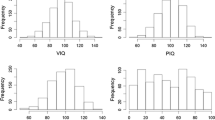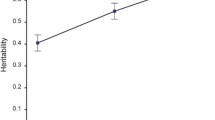Abstract
The incidence of birth stress was found to be slightly lower in individuals writing with an inverted hand position than in those writing with a normal position, a result in the opposite direction to that reported by Searleman, Porac, and Coren (1982). A familial study suggested that an inverted writing hand position was primarily related to maternal (but not paternal) writing hand position, suggesting a modeling or imitative origin, rather than a genetic basis for writing position.
Similar content being viewed by others
References
Baker, R.J., & Nelder, J.A. (1978).The GLIM system, Release 3. Oxford: Numerical Algorithms Group.
Bradshaw, J.L., & Nettleton, N.C. (1983).Human cerebral asymmetry. Englewood Cliffs, N.J.: Prentice-Hall.
Buchtel, H.A. & Rueckert, L. (1974). Hand posture in writing: Possible artifacts from self report.Cortex, 20, 435–439.
Chamberlain, G., & Johnstone, F.D. (1975). Reliability of the history.Lancet, i, 103.
Cohen, J. (1969).Statistical power analysis for the behavioural sciences. New York: Academic Press.
Everitt, B.S. (1984).An introduction to latent variable models. London: Chapman and Hall.
Levy, J. (1982). Hand-writing posture and cerebral organisation: How are they related?Psychological Bulletin, 91, 589–608.
Levy, J., & Reid, M. (1976). Variations in writing posture and cerebral organisation.Science, 194, 337–339.
Levy, J., & Reid, M. (1978). Variations in cerebral organisation as a function of handedness, hand posture in writing, and sex.Journal of Experimental Psychology: General, 107, 109–144.
McManus, I.C. (1979). Determinants of Laterality in Man. Unpublished Ph.D. diss., University of Cambridge.
McManus, I.C. (1981). Handedness and birth stress.Psychological Medicine, 11, 485–496.
Rosenthal, R. (1979). The “file-drawer problem” and tolerance for null results.Psychological Bulletin, 86, 638–641.
Searleman, A., Porac, C., & Coren, S. (1982). The relationship between birth stress and writing hand posture.Brain and Cognition, 1, 158–164.
Tapley, S.M., & Bryden, M.P. (1983). Hand-writing position and hemispheric asymmetry in right-handers.Neuropsychologia, 21, 129–138.
Weber, A.M., & Bradshaw, J.L. (1981). Levy and Reid’s neurological model in relation to writing hand/posture: An evaluation.Psychological Bulletin, 90, 74–88.
Author information
Authors and Affiliations
Rights and permissions
About this article
Cite this article
McManus, I.C. Writing hand position, birth stress, and familial factors. Current Psychology 4, 195–203 (1985). https://doi.org/10.1007/BF02686570
Accepted:
Published:
Issue Date:
DOI: https://doi.org/10.1007/BF02686570




